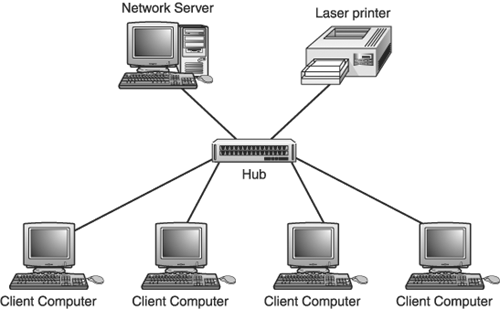Understanding Ethernet
| As with many of the PC and network technologies that we use today, Ethernet got its start in 1972 at the Xerox Palo Alto Research Center (PARC). Xerox actually released a commercial version of Ethernet in 1975 that provided a transmission speed of 3Mbps. Ethernet was a big hit, and Xerox, Intel, and the Digital Equipment Corporation (DEC) worked together to modify the Ethernet specifications and produced a version that provided a data transmission speed of 10Mbps. It is this 10Mbps flavor of Ethernet that was standardized by the IEEE in its 802.3 specifications (which we look at later in the chapter). Ethernet is the most commonly used network architecture in the world. Let's look at how Ethernet controls the access of computers and other devices to the network. Ethernet Network Access StrategyEthernet is a passive, wait-and-listen network architecture. Computers must contend for transmission time on the network medium. In fact, Ethernet is commonly described as a contention -based architecture . Ethernet provides access to the network using Carrier Sense Multiple Access with Collision Detection (CSMA/CD) . This strategy of network access basically means that the devices (such as computers) on the network listen to the network and wait until the line is clear; they "sense" when the line is clear and they can transmit data. The computer then sends its packets out onto the line. If there is more than one computer transmitting, collisions result. Sensing the collisions, the computers stop transmitting and wait until the line is free. One of the computers will then transmit, gaining control of the line and completing the transmission of the data. To receive data, computers just sit and wait, listening to the line. When they sense that a particular transmission is meant for them, they receive it on their network card. Believe it or not, collisions are very common on Ethernet networks. Devices such as hubs (which we discussed in Chapter 3, "Networking Hardware") have a collision light on their front panel, and you will see it blink fairly often, letting you know that collisions have taken place on the LAN. Collisions are only a problem if they become excessive. The main advantage of Ethernet is that it is one of the cheapest network architectures to implement. Network interface cards, cabling, and hubs are fairly inexpensive when compared to the hardware required for other architectures such as Token Ring (which we discuss shortly). A major disadvantage of Ethernet relates to collisions on the network. The more collisions, the slower the network will run, and excessive collisions can even bring down the network. As far as network topologies go, Ethernet networks typically will be found in a bus or star configuration, depending on the type of cabling used. With twisted-pair cabling becoming more and more popular and hubs becoming very affordable, most Ethernet networks will be configured in a star topology, as shown in Figure 4.1. Figure 4.1. Ethernet LANs are typically arranged in a star topology, with a hub at the center of the star. Tip
Fast EthernetFaster versions of Ethernetfaster than the original 10Mbps flavor of Ethernethave been developed. Fast Ethernet is so named because of its "faster" throughput speed (when compared to the 10Mbps version). Fast Ethernet provides a bandwidth of 100Mbps. This faster throughput is due to the fact that the time it takes to transmit a bit of information over the Ethernet media has been reduced by a factor of 10. So, Fast Ethernet is able to run 10 times faster than 10Mbps Ethernet, thus providing 100Mbps throughput. Fast Ethernet cannot run over network cards and hubs designed for a 10Mbps Ethernet network. However many hubs, switches, and Ethernet network cards are now 10/100 switchable and so can accommodate 10Mbps or Fast Ethernet. Gigabit EthernetAn even faster version of Ethernet is Gigabit Ethernet, which uses the same IEEE Ethernet specifications and the same data format as the other versions of Ethernet. Gigabit Ethernet provides a data transmission speed of 1,000Mbps. While Fast Ethernet has been implemented on LANs using both twisted-pair and fiber-optic cabling, Gigabit Ethernet was originally restricted to fiber- optic -based networks and required high-speed switches and specialized servers. Gigabit Ethernet was thought of as a high-speed backbone medium for large LANs. However, Gigabit Ethernet is now available within the LAN and Gigabit network cards can be deployed in network clients and servers. Category 5 cable can also be used as the Gigabit Ethernet connectivity medium (more about cabling later in the chapter). A faster version of Gigabit Ethernet, 10Gigabit Ethernet is currently in the works. It also has potential over both fiber optic and copper -based cabling media. Ethernet IEEE and Cable SpecificationsThe IEEE provides specifications for a number of the technologies related to networking computers, including Ethernet. The list that follows shows some of these specifications:
As you can see from the list, Ethernet is defined by the IEEE 802.3 specifications. Ethernet operates at the Data Link layer of the OSI conceptual model (discussed in Chapter 5). A number of different IEEE types of Ethernet exist depending on the variety of cabling used on the network (we will discuss different cable types in more detail later in the chapter, in the section "Cabling Options"). These types of Ethernet, Fast Ethernet and Gigabit Ethernet, are designated by three-part names , such as 10BASE-T . The first part of the name (such as 10 or 100) designates the transmission speed. For example, 10 indicates 10Mbps Ethernet. The second part of the name, which will be "base" for all the types of Ethernet, specifies that the Ethernet signal is a baseband signal. This means that the data flows in a stream in a single signal. This type of transmission cannot carry multiple channels of information as can the alternative, broadband (we discuss broadband technologies such as the T-Carrier system in Chapter 13, "Expanding a LAN with WAN Technology," and we look at broadband Internet connections in Chapter 15, "Connecting a Network to the Internet"). The final part of the Ethernet type name designates the kind of cable used. For example, in the type name 10BASE-T, the T specifies twisted-pair cable wire, and it is assumed that this is unshielded twisted-pair cable (it's also assumed that you would use Category 5 unshielded twisted-pair wire for networkingmore about cabling later in the chapter). Now that we've sorted out the naming conventions, we can take a look at the Ethernet and Fast Ethernet standards available. These different varieties of Ethernet are summarized in the list that follows:
As already mentioned, you will find that many of the network cards and hubs you buy now support both 10Mbps and Fast Ethernet (the devices are switchable). Also, just about anyone putting together a new Ethernet network would use Category 5 (CAT 5) twisted-pair wiring (or CAT 6 if they wish to spend more and have the option of taking advantage of faster Ethernet specifications in the future). Most new network cards only support RJ-45 connectorsthe male connector type used on twisted-pair wiring. Larger companies may use some fiber-optic cabling as a high-speed backbone between floors, but copper-base cable is still the norm. |
EAN: 2147483647
Pages: 188

